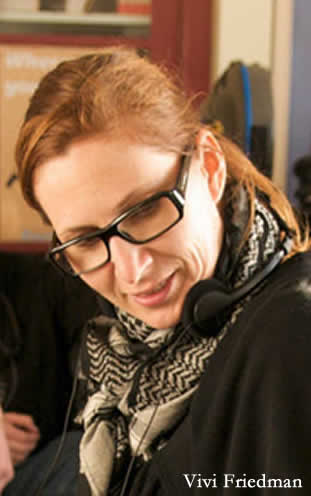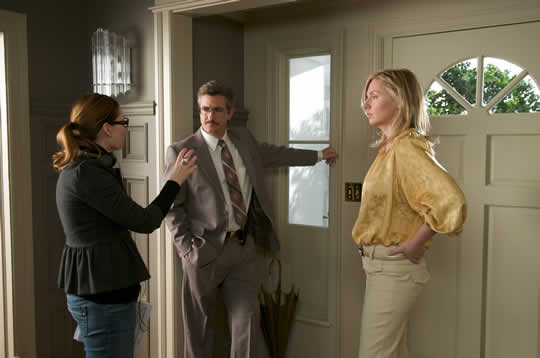 The Family Tree is the story of the dysfunctional Burnett family – Bunnie (Hope Davis), Jack (Dermot Mulroney) and their twin 17-year-olds, Eric (Max Thieriot) and Kelly (Britt Robertson). When a freak accident leaves Bunnie with a case of amnesia, the Burnetts get an unexpected second chance at happiness. Meanwhile, next door neighbor Simon (Chi McBride) is relieved that his tryst gone wrong with Bunnie remains undetected, at least for the moment. Before long, a slew of past relationships, kids with guns, a suicidal teacher, a very zealous religious club, misinterpreted advances, corporate down-sizing, and one fateful squirrel combine to create enough mayhem to test the resolve, sanity and future of any family!
The Family Tree is the story of the dysfunctional Burnett family – Bunnie (Hope Davis), Jack (Dermot Mulroney) and their twin 17-year-olds, Eric (Max Thieriot) and Kelly (Britt Robertson). When a freak accident leaves Bunnie with a case of amnesia, the Burnetts get an unexpected second chance at happiness. Meanwhile, next door neighbor Simon (Chi McBride) is relieved that his tryst gone wrong with Bunnie remains undetected, at least for the moment. Before long, a slew of past relationships, kids with guns, a suicidal teacher, a very zealous religious club, misinterpreted advances, corporate down-sizing, and one fateful squirrel combine to create enough mayhem to test the resolve, sanity and future of any family!
Vivi Friedman, director of The Family Tree, was born and raised in Finland, where she directed her first commercial shortly after high school. Vivi’s passion for film took her to the United States with a scholarship to study film at the University of Rochester. She later continued her studies in TV and Film at UCLA and began an international commercial directing career that continues to this day.
In 2003 Vivi shot her short film Certainly Not a Fairy Tale, starring Linda Cardellini and Jason Segel for Fox Searchlight’s prestigious Searchlab, one of the industry’s most highly-regarded programs for developing the next generation of filmmakers. Vivi speaks five languages and has worked all over the world. She currently lives in Los Angeles.
Bijan Tehrani: What motivated you to make The Family Tree?
Vivi Friedman: At the time when I found the screenplay, I wanted to find my first script for my first feature film. I had just completed a short film which was a fairy tale, which was made for Fox SearchLab, and it was viewed by a manager who wrote Driving Lessons and he just thought that, based on my short, that maybe my sensibilities would lead me to enjoy Driving Lessons. Now it is called The Family Tree, but at the time it was called Driving Lessons and I did and what appealed to me. I suppose it was the fact that it was looking at all of theses issues here in the United States that we are inadvertently experiencing everyday—whether in the political or social environment, there are all sorts of issues like school shootings and talks about religion, and it seems like a very black and white world. I like the way the script was taking all of those issues in the guise of a satire or dark comedy and allowing us to see that these are very wonderful but very flawed people, all looking to find themselves, and the lesson in the end is that everybody is entitled to their opinion and everybody is worthy of love. 
BT: It is interesting the way the subject is treated by you as a filmmaker; did your Scandinavian background help you with the film especially in terms of its dark humor?
VF: I think this film is the script and I felt that it had to be handled very carefully. Where I am from, we tend to laugh on the inside rather than the outside, and my sensibility is not so much into comedy. I like all things with irony and satire and certain dark humor, but I felt that the subject matter was so sensitive that if you made it in this arena of broad comedy, then it would deflate the message. I wanted there to be a message in the subtext that created a hopeful sensitivity, then that would come through. Being from another culture can be a hindrance as well; there is the question in ones mind of whether other would be able to interpret this in a similar way. So, I just hope that there is an audience that would be able to appreciate this kind of humor and filmmaking.
BT: I think this film was a little bit about tolerance between individuals, and what is happening in congress with the debt ceiling was a good example of this, so I think that this was brilliantly done.
VF: I am so happy to hear that, thank you so much for saying that.
BT: How did you go about casting the film?
VF: Well, we were very lucky that, at the point of casting, we had very wonderful producers in J. Harry and Alana Jones and they were able to make actual offers to actors so they would take our approach seriously. We had our dream list for the cast, of course,  and Hope Davis was always my ideal candidate for Bunny. I figured that she would be one of the only actresses who could actually embody somebody that was beautiful and doll-like, and on the other hand someone still very soulful and fragile. Also, she would be able to pull off being called Bunny. With Dermot Mulroney, I loved the idea of casting against character and have him play something so opposite of those handsome leading man roles. He is such a talented, amazing actor and the skill that he brought to the film was wonderful and I was humbled to have such a wonderful and awesome cast.
and Hope Davis was always my ideal candidate for Bunny. I figured that she would be one of the only actresses who could actually embody somebody that was beautiful and doll-like, and on the other hand someone still very soulful and fragile. Also, she would be able to pull off being called Bunny. With Dermot Mulroney, I loved the idea of casting against character and have him play something so opposite of those handsome leading man roles. He is such a talented, amazing actor and the skill that he brought to the film was wonderful and I was humbled to have such a wonderful and awesome cast.
BT: How did you work with the actors? Did you do a lot of rehearsals or were they allowed to improvise on the set while shooting?
VF: When I first met Hope and Dermot, and being a first time director, I was shy and humble. I let them know that I was there for them and they both said that they don’t like to rehearse, so it was more hanging out and telling stories about the characters and the character arcs. Their rehearsals were more walking and pacing and bringing the younger actors into the fold of the story. There were some more rehearsals that we did with the younger actors and they were wonderful and so talented. It was great how everyone had their own way of arriving at the character and what they needed from me as a director. For example, Dermot had more questions about the subject and the motivation, whereas the younger actors would do exactly what I wanted them to do. It was a good process of finding what everyone needed, and I am not a fan of rehearsing too much—I want the actors to go with whatever theme or thoughts that they have.
BT: How did you come up with the visual style of the film? 
VF: For this film, I had certain films that I had in mind with visual styles that I thought would work. For instance, the film Election (1999) inspired me, and The Royal Tenenbaums was a great influence as well—I thought that those were films where we had all of these issues. I wanted the wardrobe to describe who the characters really were in my film, so Jack is always very beige and brown and Eric is always red and white; and Bunny is always red and yellow, and Kelly is green and purple. So, they are all their own characters with their own colors and I wanted to make it very stylized. I hoped that this hyper-real approach would highlight the satirical elements of the story line.
BT: Do you have projects lined up for the future?
VF: I think filmmakers always have something in the works; I have a few screenplays that I am working on and, for my next project, I would love to move into drama or something more magical. I feel like maybe moving from dark comedies. I always loved dark comedies and they appeal to me greatly, but I would like to work on something very heartfelt, so we will see—hopefully something soon!

